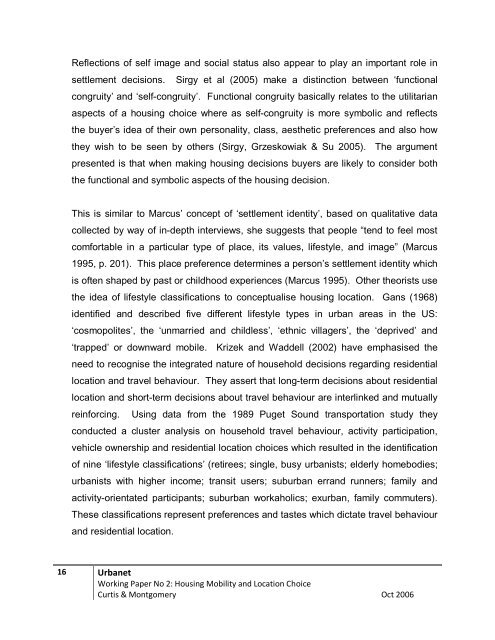Housing Mobility and Location Choice - Urbanet - Curtin University
Housing Mobility and Location Choice - Urbanet - Curtin University
Housing Mobility and Location Choice - Urbanet - Curtin University
Create successful ePaper yourself
Turn your PDF publications into a flip-book with our unique Google optimized e-Paper software.
Reflections of self image <strong>and</strong> social status also appear to play an important role in<br />
settlement decisions. Sirgy et al (2005) make a distinction between ‘functional<br />
congruity’ <strong>and</strong> ‘self-congruity’. Functional congruity basically relates to the utilitarian<br />
aspects of a housing choice where as self-congruity is more symbolic <strong>and</strong> reflects<br />
the buyer’s idea of their own personality, class, aesthetic preferences <strong>and</strong> also how<br />
they wish to be seen by others (Sirgy, Grzeskowiak & Su 2005). The argument<br />
presented is that when making housing decisions buyers are likely to consider both<br />
the functional <strong>and</strong> symbolic aspects of the housing decision.<br />
This is similar to Marcus’ concept of ‘settlement identity’, based on qualitative data<br />
collected by way of in-depth interviews, she suggests that people “tend to feel most<br />
comfortable in a particular type of place, its values, lifestyle, <strong>and</strong> image” (Marcus<br />
1995, p. 201). This place preference determines a person’s settlement identity which<br />
is often shaped by past or childhood experiences (Marcus 1995). Other theorists use<br />
the idea of lifestyle classifications to conceptualise housing location. Gans (1968)<br />
identified <strong>and</strong> described five different lifestyle types in urban areas in the US:<br />
‘cosmopolites’, the ‘unmarried <strong>and</strong> childless’, ‘ethnic villagers’, the ‘deprived’ <strong>and</strong><br />
‘trapped’ or downward mobile. Krizek <strong>and</strong> Waddell (2002) have emphasised the<br />
need to recognise the integrated nature of household decisions regarding residential<br />
location <strong>and</strong> travel behaviour. They assert that long-term decisions about residential<br />
location <strong>and</strong> short-term decisions about travel behaviour are interlinked <strong>and</strong> mutually<br />
reinforcing. Using data from the 1989 Puget Sound transportation study they<br />
conducted a cluster analysis on household travel behaviour, activity participation,<br />
vehicle ownership <strong>and</strong> residential location choices which resulted in the identification<br />
of nine ‘lifestyle classifications’ (retirees; single, busy urbanists; elderly homebodies;<br />
urbanists with higher income; transit users; suburban err<strong>and</strong> runners; family <strong>and</strong><br />
activity-orientated participants; suburban workaholics; exurban, family commuters).<br />
These classifications represent preferences <strong>and</strong> tastes which dictate travel behaviour<br />
<strong>and</strong> residential location.<br />
16 <strong>Urbanet</strong><br />
Working Paper No 2: <strong>Housing</strong> <strong>Mobility</strong> <strong>and</strong> <strong>Location</strong> <strong>Choice</strong><br />
Curtis & Montgomery Oct 2006


